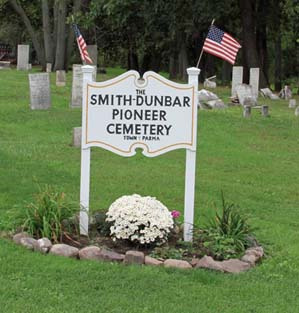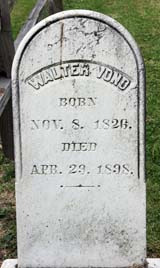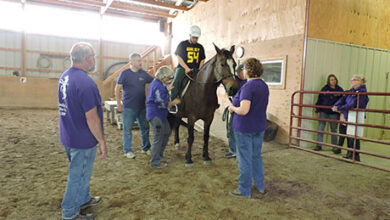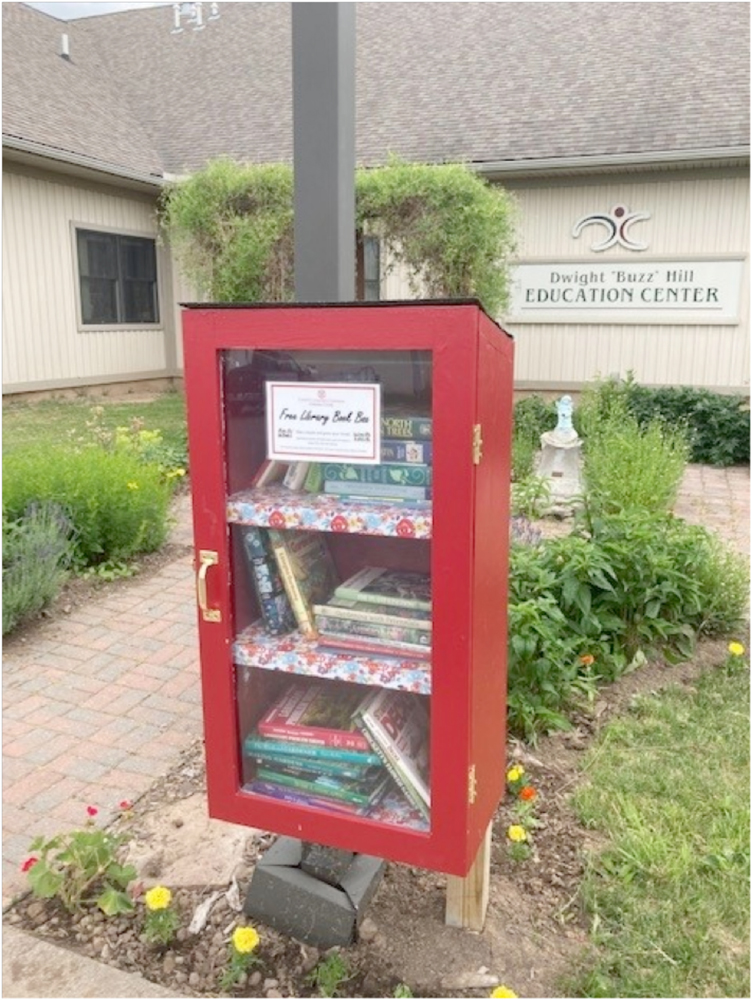Dunbar Road Cemetery restoration project launched
by David Crumb
 The picturesque old country cemetery located on the south side of West Creek north of Hilton on Lake Avenue and the corner of Dunbar Road is the resting place of Hilton’s pioneer founding fathers.
The picturesque old country cemetery located on the south side of West Creek north of Hilton on Lake Avenue and the corner of Dunbar Road is the resting place of Hilton’s pioneer founding fathers.
Parma Union Cemetery did not exist until 1850, and the Parma citizens buried their dead either in six small cemeteries scattered around the town or on their own land in family plots. The Dunbar Cemetery as it used to always be referred to, and now known also as the Smith Family Cemetery, served old Unionville (now Hilton) and North Parma (Bartlett’s Corners at the intersection of North Avenue and Curtis Road). The earliest grave on record is Lucy Cheney, wife of John Cheney. She was interred on August 11, 1811. The last interment was about 1900.
As we celebrate the 200th anniversary of the War of 1812 between the young United States and Great Britain and Canada, it brings to mind some of the Parma men who served the nation in that historic conflict. Six 1812 veterans from Parma are buried in the Dunbar Cemetery and some of them still have descendants in the area. Some of their graves are noted and faithfully marked with a new flag each Memorial Day, thanks to the efforts of Tom Burger and other historians, but other stones lay in a sad state of disrepair.
 The War of 1812 veterans in the Dunbar Cemetery are: William Henry who was 56 when he served; John Henry, Ezra Tyler, Ira Cheney, George Dunbar, and William Raymond. William Henry, for whom Henry Street in Hilton was named, also served in the 1776 American Revolution. Parma raised a Militia during the War of 1812 and the soldiers drilled on the land by Salmon Creek now a parking lot for Tops Market, CVS, and other commercial establishments. Colonel Johnson Servis was in charge of the Parma Company. Major Lockwood, Captain Jonathan Leonard Sr., and Sgt. John Henry were the officers. None of the soldiers saw active combat, but were none the less prepared for British and Canadian raids on frontier settlements close to Lake Ontario. History relates according to O.S. Turner’s 1851 account in The History of Monroe County: “Never at any period, in any situation, did men more cheerfully or promptly take up arms and from citizens become soldiers, than did most of the able bodied men from this region.”
The War of 1812 veterans in the Dunbar Cemetery are: William Henry who was 56 when he served; John Henry, Ezra Tyler, Ira Cheney, George Dunbar, and William Raymond. William Henry, for whom Henry Street in Hilton was named, also served in the 1776 American Revolution. Parma raised a Militia during the War of 1812 and the soldiers drilled on the land by Salmon Creek now a parking lot for Tops Market, CVS, and other commercial establishments. Colonel Johnson Servis was in charge of the Parma Company. Major Lockwood, Captain Jonathan Leonard Sr., and Sgt. John Henry were the officers. None of the soldiers saw active combat, but were none the less prepared for British and Canadian raids on frontier settlements close to Lake Ontario. History relates according to O.S. Turner’s 1851 account in The History of Monroe County: “Never at any period, in any situation, did men more cheerfully or promptly take up arms and from citizens become soldiers, than did most of the able bodied men from this region.”
 During Parma’s Bicentennial year (2009) a great effort was made to restore all of Parma’s small historic cemeteries. Five of the six cemeteries were renovated. Fallen and lopsided stones were straightened. Stones long forgotten and buried underground were righted in their proper place. Footstones were reunited with their proper headstone. These five cemeteries never looked so good. Sadly for some reason the Dunbar cemetery never received the same attention. While the lawn is mowed, and the fence kept in repair, many stones remain broken and askew due to years of frost and shifting of the earth. Two family plots are enclosed with 1860 vintage cast iron Victorian fences. Those neglected fences are becoming rusted, disconnected and otherwise deteriorated.
During Parma’s Bicentennial year (2009) a great effort was made to restore all of Parma’s small historic cemeteries. Five of the six cemeteries were renovated. Fallen and lopsided stones were straightened. Stones long forgotten and buried underground were righted in their proper place. Footstones were reunited with their proper headstone. These five cemeteries never looked so good. Sadly for some reason the Dunbar cemetery never received the same attention. While the lawn is mowed, and the fence kept in repair, many stones remain broken and askew due to years of frost and shifting of the earth. Two family plots are enclosed with 1860 vintage cast iron Victorian fences. Those neglected fences are becoming rusted, disconnected and otherwise deteriorated.
The Hilton Parma Historical Society is focusing their immediate attention on raising funds and initiating volunteers to put the Dunbar Cemetery back in its proper and respectable condition. Through the leadership of John Toal, many stones were straightened to their upright position last year, and mason Joseph Rauber skillfully repaired the stone of Nero Vond, Parma’s first African American and former slave. The Historical Society has created a Dunbar Cemetery fund to receive donations for the restoration project. Parma residents, and family members of the old pioneers, are encouraged to make a donation to this historic landmark project. Those wishing to do so should make checks payable to the Hilton Parma Historical Society, and to the attention of Parma Historian, Donald Stilson, 1300 Hilton-Parma Corners Road (Route 259), Hilton, NY 14468.





